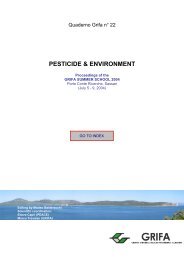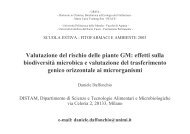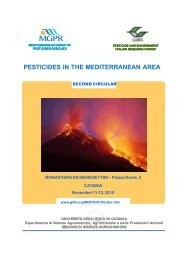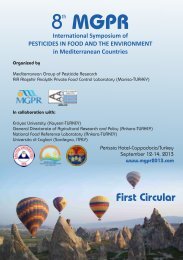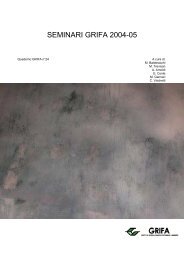International Congress BIOLOGICAL PRODUCTS - Gruppo di ...
International Congress BIOLOGICAL PRODUCTS - Gruppo di ...
International Congress BIOLOGICAL PRODUCTS - Gruppo di ...
You also want an ePaper? Increase the reach of your titles
YUMPU automatically turns print PDFs into web optimized ePapers that Google loves.
2<br />
LUPINUS ALBUS, AN ANCIENT EUROPEAN LEGUME PARTICULARLY SUITABLE FOR ORGANIC<br />
FARMING, MAY BECOME AN USEFUL SOURCE OF FUNCTIONAL INGREDIENTS<br />
Anna Arnol<strong>di</strong>, Alessandra D’Agostina, Giovanna Boschin<br />
DISMA, Section of Chemistry – University of Milan (anna.arnol<strong>di</strong>@unimi.it)<br />
Lupin is a protein rich grain legume typical of the Me<strong>di</strong>terranean region that produces seeds with a protein content, both<br />
qualitatively and quantitatively similar to that of soybean. A very interesting advantage of lupin in respect to soybean is<br />
that there are no commercially available genetically mo<strong>di</strong>fied varieties, which makes it an ideal crop for organic<br />
farming. In ad<strong>di</strong>tion it is particularly valuable in Me<strong>di</strong>terranean areas, owing to its drought resistant properties, and,<br />
being a legume, it may be used in rotation with other cultures to reduce the use of fertilisers. For these reasons the<br />
European Commission has included it in the list of plants that merit specific research efforts (1).<br />
The protein content of lupin, varying from species to species, is around 35 to 40% in Lupinus albus. About 10% of the<br />
total protein content consists of albumins, while the rest is represented by globulins, showing a 1:1 legumin<br />
(11S)/vicilin (7S) ratio. Ultracentrifugation of the protein solutions leads to 4 fractions with se<strong>di</strong>mentation coefficients<br />
of 15S, 11S, 7S and 2S. The major fractions are the 11S and the 7S fractions, which account for about 33 to 37% of<br />
total proteins (2). In ad<strong>di</strong>tion, lupin contains a specific protein fraction, conglutin γ, which accounts for about 5% of<br />
total proteins and has the exceptional characteristic of being a sulphur-rich protein, thus containing amino acids that are<br />
scarce in other grain legumes.<br />
In respect to soybean, lupin kernels contain lower amounts of antinutrients, potentially of consumer concern, when<br />
using protein ingre<strong>di</strong>ents in food preparations. Trypsin inhibitor concentration is, in fact, 0.18 mg/g in lupin vs. 17.90<br />
mg/g in soybean, phytate concentration is 0.44 mg/g vs. 1.59 mg/g, saponin concentration is 1.4 mg/g vs. 1.9 mg/g, and<br />
the concentration of oligosaccharides of the raffinose family is 4.6 mg/g vs. 5.7 mg/g (3). Lupin alkaloids, which, also<br />
for their bitter taste, represented a strong limitation for the human consumption of some old lupin varieties, have now<br />
been reduced to very low levels in the “sweet lupin” varieties (4). Sweet lupin flour has been suggested for use in bread,<br />
cookies and milk substitutes. Manufacturers advertise that these products have an increased <strong>di</strong>etary fibre content and<br />
high protein value. Ad<strong>di</strong>tionally lupin seeds do not contain phyto-hormones, in particular isoflavones that, accor<strong>di</strong>ng to<br />
recent literature data, have serious toxicological potentials.<br />
In the last decade, the increasing awareness of the health consequences of an incorrect <strong>di</strong>et and some scandals in the<br />
meat market (BSE, epizootic aphtha, contamination with polychloro-<strong>di</strong>benzo<strong>di</strong>oxines and/or furans residues) have<br />
encouraged the consumers to go back to legumes as a source of valuable proteins. In this situation, lupin seeds have all<br />
the characteristics to become one of the main source of vegetable food ingre<strong>di</strong>ents in the Me<strong>di</strong>terranean area.<br />
1. European Economic and Social Committee, Section for Agriculture, Rural Development and the Environment,<br />
‘New impetus for a plan for plant protein crops in the Community’, Brussels, 4 December 2001.<br />
2. Guegen J, Cerletti P. In New and Developing Sources of Food Proteins. Hudson, BJF ed., Chapman and Hall,<br />
London 1994, 145-193.<br />
3. Champ M. Procee<strong>di</strong>ngs 4th Europ. Conference on Grain Legumes, 2001, 109-113.<br />
4. Muzquiz M, Pedrosa MM, Cuadrado C, Ayet G, Burbano C, Brenes A In Recent Advances of Research in<br />
Antinutritional Factors in Legume Seeds and Rape Seeds. Jasman AJM et al eds, EAAP Publication N. 93,<br />
Wageningen Press, 1998, 387-390.<br />
PDF creato con FinePrint pdfFactory versione <strong>di</strong>mostrativa http://www.secom.re.it/fineprint<br />
49



